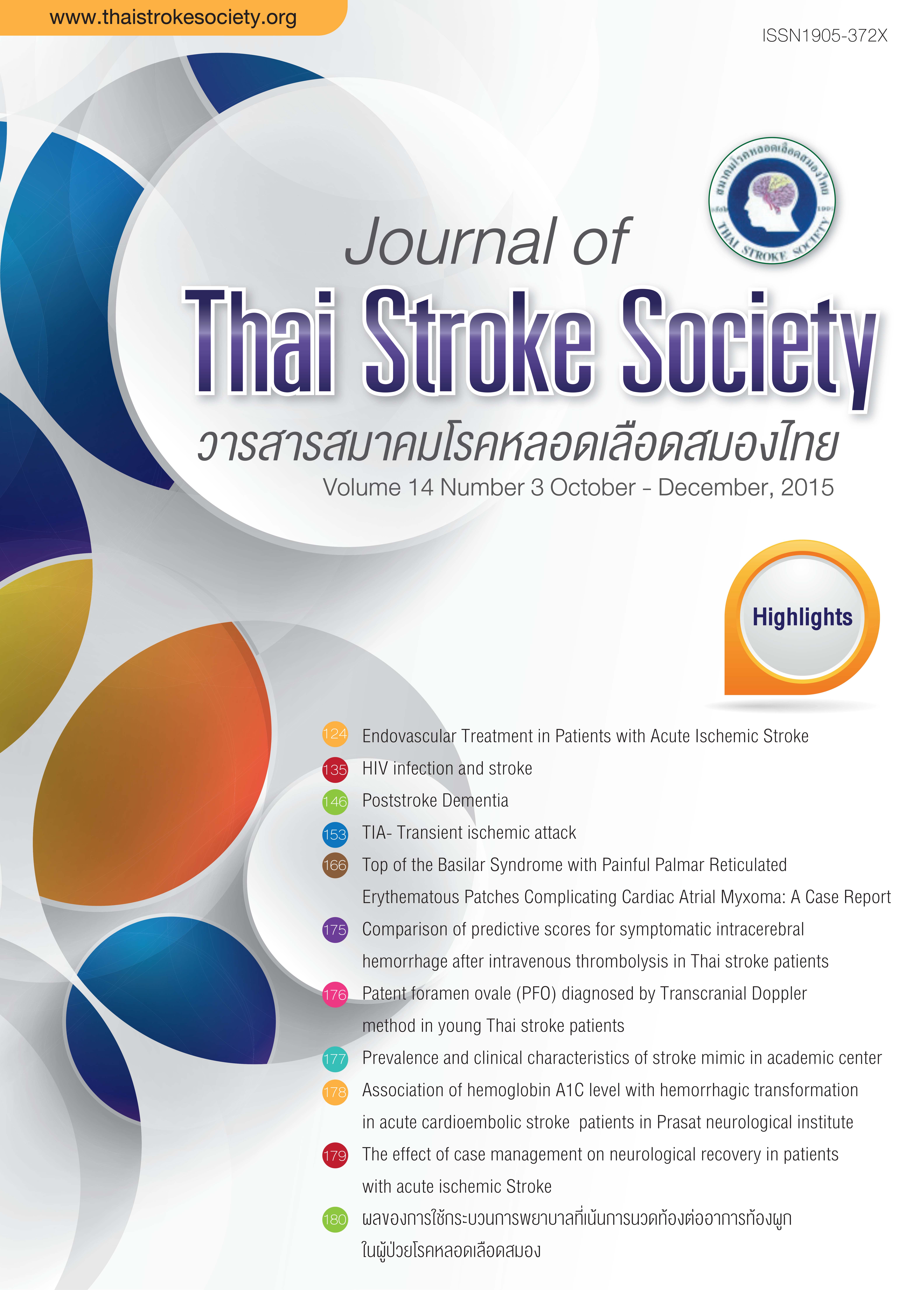Controversies of thrombolytic therapy in acute ischemic stroke
Abstract
Intravenous thrombolysis is approved to treat eligible patients with acute ischemic stroke. However, some controversies remain. Whether efficacy is outweighed risks of the treatment in particular groups of the patients such as those with severe or very mild severities of stroke or very old patients or wake-up stroke, is still debated. Most patients with severe stroke had major artery occlusion. Intravenous thrombolysis has limited efficacy in recanalization. Recently, combination of intravenous thromobolysis and endovascular treatment showed higher rates of recanalization and provided better clinical outcomes than those with intravenous thrombolysis alone. This would be another, better option in treatment of patients with acute severe ischemic stroke. More evidences have shown the benefit of intravenous thrombolysis in patients with very old (> 80 years old) in term of clinical outcomes as compared to those without treatment. There are ongoing studies looking for the benefit of intravenous thrombolysis in patients with very mild stroke or wake-up stroke.
References
professionals from the American Heart Association/American Stroke Association. Stroke 2013; 44: 870-947.
Wardlaw JM, Murray V, Berge E, et al. Recombinant tissue plasminogen activator for acute ischemic stroke: an updated systemic review and meta-analysis.
Lancet 2012; 379: 2364-2372.
Dharmasaroja PA, Dharmasaroja P, Muengtaweepongsa S. Outcomes of Thai patients with acute ischemic stroke after intravenous thrombolysis. J Neurol Sci
2011; 300: 74-77.
Fischer U, Arnold M, Nedeltchev K, et al. NIHSS score and arteriographic findings in acute ischemic stroke. Stroke 2005; 36: 2121-2125.
Saqqur M, Uchino K, Demchuk AM, et al. Site of arterial occlusion identified by transcranial Doppler predicts the response to intravenous thrombolysis for
stroke. Stroke 2007; 38: 948-954.
Emberson J, Lees KR, Lyden P, et al. Effect of treatment delay, age, and stroke severity on the effects of intravenous thrombolysis with alteplase for
acute ischaemic stroke: a meta-analysis of individual patient data from randomized trials. Lancet 2014; 384: 1929-1935.
2015 American Heart Association/ American Stroke Association focused update of the 2013 guidelines for the early management of patients with acute
ischemic stroke regarding endovascular treatment: A guideline for healthcare professionals from the American Heart Association/ American Stroke
Association. Stroke 2015; 46: 3020-3035.
Khatri P, Tayama D, Cohen G, et al. Effect of intravenous recombinant tissue-type plasminogen activator in patients with mild stroke in the third International Stroke Trial-3: Post Hoc Analysis. Stroke 2015; 46: 2325-2327.
Dharmasaroja PA, Muengtaweepongsa S, Dharmasaroja P. Intravenous thrombolysis in Thai patients with acute ischemic stroke: role of aging. J Stroke Cerebrovasc Dis 2003; 22: 227-231.
Dharmasaroja PA, Muengatweeponsa S, Pattaraarchachai J, Dharmasoroja P. Stroke outcomes in Thai elderly patients treated with and without intravenous thrombolysis. Neurol Int 2013; 5: e15.
Rimmele DL, Thomalla G. Wake-up stroke: clinical characteristics, imaging findings, and treatment option- an update. Front Neurol 2014; 26: 35.
Silva GS, Lima FO, Camargo EC, et al. Wake-up stroke: clinical and neuroimaging characteristics. Cerebrovasc Dis 2010; 29: 336-342.
Huisa BN, Liebeskind DS, Raman R, et al. Diffusion-weighted imaging-fluid attenuated inversion recovery mismatch in nocturnal stroke patients with unknown time of onset. J Stroke Cerebrovasc Dis 2013; 22: 927-977.
Downloads
Published
How to Cite
Issue
Section
License
ข้อความภายในบทความที่ตีพิมพ์ในวารสารสมาคมโรคหลอดเลือดสมองไทยเล่มนี้ ตลอดจนความรับผิดชอบด้านเนื้อหาและการตรวจร่างบทความเป็นของผู้นิพนธ์ ไม่เกี่ยวข้องกับกองบรรณาธิการแต่อย่างใด การนำเนื้อหา ข้อความหรือข้อคิดเห็นของบทความไปเผยแพร่ ต้องได้รับอนุญาตจากกองบรรณาธิการอย่างเป็นลายลักษณ์อักษร ผลงานที่ได้รับการตีพิมพ์ในวารสารเล่มนี้ถือเป็นลิขสิทธิ์ของวารสาร





